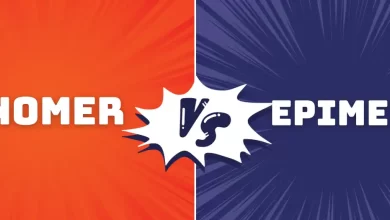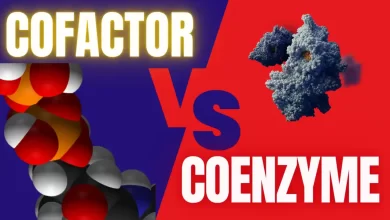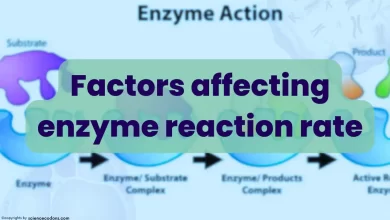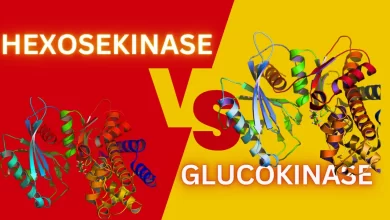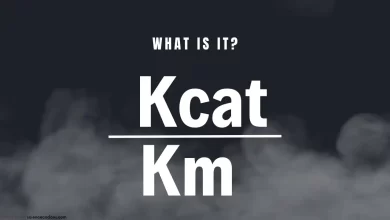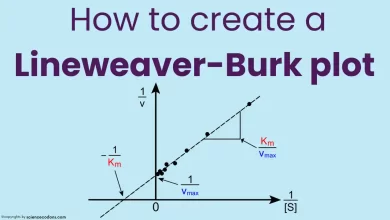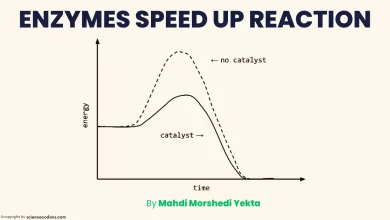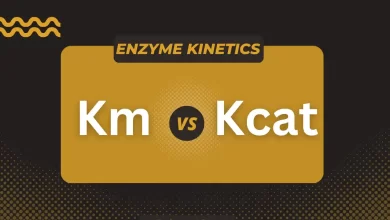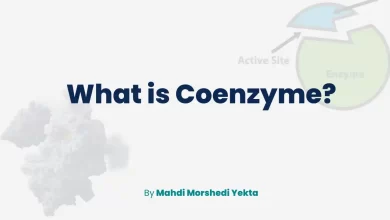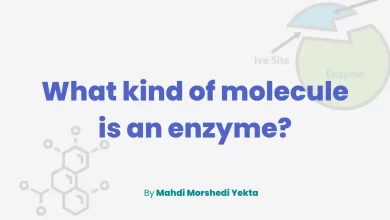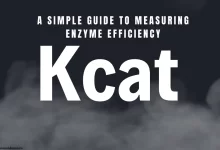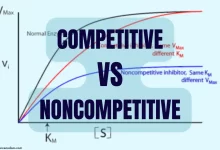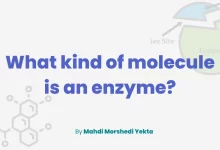According to the latest changes made on the Expasy website, enzyme classification has changed from 6 classes to 7 classes. In this post, we will discuss all 7 classes of enzymes(oxidoreductases, transferases, hydrolases, lyases, isomerases, ligases, and translocases) along with their subclasses.
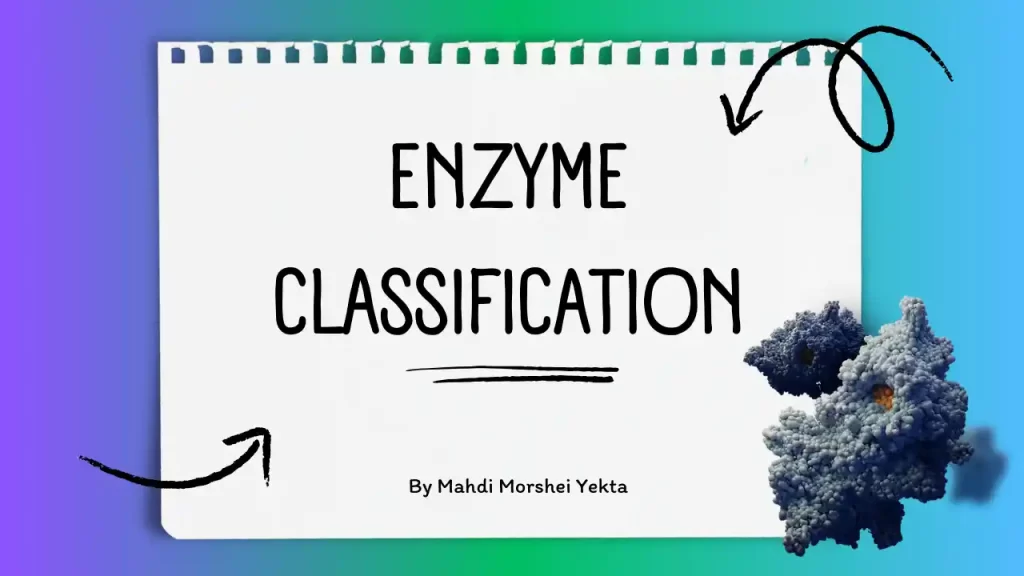
before talking about all Types of enzymes and their functions, we should know about Enzyme nomenclature methods and EC numbers in enzymology science.
Enzyme nomenclature
In the early 19th century, when enzymes were identified, there was no specific method for naming them. Many enzymes were named by adding the suffix -in. Examples of this type of nomenclature are pepsin, trypsin, and ptyalin. With the increase in the number of enzymes, this type of nomenclature became confusing. Therefore, a new method was invented for naming enzymes. The new method added a suffix -ase or a part of it to the name. For example, arginase and urease are named using this method. In this method, the reaction type is sometimes added to the enzyme’s name. For example, pyruvate carboxylase refers to pyruvate carboxylation. Currently, the International Commission has proposed four numbers for each enzyme. The first number specifies the enzyme class. The second and third numbers describe the type of reaction, and the fourth number is specific to the enzyme. This four-part number creates the EC number. (like EC: 1.1.1.3= homoserine dehydrogenase.)
What are the 7 types of enzymes?
| Enzyme Classification | Function |
|---|---|
| EC 1: Oxidoreductases | Catalyze oxidation-reduction reactions. |
| EC 2: Transferases | Transfer functional groups between molecules. |
| EC 3: Hydrolases | Catalyze hydrolysis reactions. |
| EC 4: Lyases | Catalyze the removal of groups from substrates by mechanisms other than hydrolysis and oxidation. |
| EC 5: Isomerases | Catalyze is the rearrangement of atoms within a molecule. |
| EC 6: Ligases | Catalyze the joining of two molecules with the input of energy. |
| EC 7: Translocases | Catalyze the movement of ions or molecules across membranes. |
EC1: Oxidoreductases
Electrons are removed from one substrate and transferred to another substrate. For example, the enzyme glucose-6-phosphate dehydrogenase (G6PD), which plays a role in the pentose phosphate pathway, converts glucose-6-phosphate to 6-phosphoglucono-δ-lactone by removing electrons. The removed electrons are transferred to +NADP and are used to reduce NADP to NADPH2.
Each of the enzymatic classes can be divided into several subclasses. In this section, we will examine the oxidoreductase subclasses to clarify the subject. The oxidoreductase class can be divided into four subclasses: oxidases, dehydrogenases, hydroperoxidases, and oxygenases.
Oxidases
Oxidases are enzymes that use oxygen as an electron acceptor. These enzymes produce water or H2O2 in their reaction. Cytochrome oxidase is an example of these enzymes. This enzyme is a homoprotein containing two iron atoms and two copper atoms. Flavoprotein oxidases contain FMN and FAD. Unlike NAD, FAD and FMN do not have a tight connection to the protein and act as prosthetic groups. If a metal element is present in the structure of flavoprotein oxidase, it is called metalloflavoprotein oxidase. L-amino acid oxidase contains the prosthetic group FMN and is present in all tissues and liver. Xanthine oxidase has FAD and requires molybdenum for activity. Aldehyde dehydrogenase contains the prosthetic group FAD and is found in the livers of mammals. This enzyme contains non-heme iron.
Dehydrogenases
Dehydrogenases are enzymes that transfer electrons from one substrate to another. These enzymes use NAD or NADP and FAD or FMN as electron acceptors. The following enzymes are examples of these enzymes, all of which have FAD as their prosthetic group: NADH dehydrogenase, succinate dehydrogenase, dihydrolipoamide dehydrogenase, acyl-CoA dehydrogenase, and mitochondrial glycerol 3-phosphate dehydrogenase. The dehydrogenases use NAD as their electron acceptor: isocitrate dehydrogenase, glycerol aldehyde 3-phosphate dehydrogenase, and malate dehydrogenase.
Hydroperoxidases
Hydroperoxidases are enzymes that break down hydrogen peroxide, which is a toxic substance for cells. Peroxidase enzymes are found in milk, leukocytes, and tissues involved in the metabolism of eicosanoids. Peroxidases have a prosthetic heme group. The catalase enzyme is present in blood, brain, bone marrow, mucous membranes, kidney, and liver. Peroxisomes are rich in peroxidase and catalase enzymes. The reaction related to peroxidases is shown below. These enzymes require a reducing agent to break down H2O2 and provide the electrons they need.
Oxygenases
Oxygenase is an enzyme that combines a substrate with oxygen. Oxidases are divided into two groups. Dioxygenases connect both oxygen atoms to their substrate. Monooxygenases only attach one oxygen atom to the substrate. Cytochromes P450 are a type of monooxygenase. These enzymes play a role in the detoxification and hydroxylation of steroids. Phenobarbital induces cytochrome P450.
EC2: Transferases
Enzymes that move groups from one molecule to another. Transfer a group such as methyl, phosphate, or sulfur from one substrate to another. For example, the enzyme hexokinase(hexokinase vs glucokinase), which is involved in the glycolysis pathway, removes a phosphate group from ATP and transfers it to carbon 6 of glucose. As a result, this transfer converts glucose to glucose 6-phosphate
2.1.-.- Transferring one-carbon groups.
Example:
ID 2.1.4.1 DE glycine amidinotransferase. CA glycine + L-arginine = guanidinoacetate + L-ornithine. CC -!- Canavanine can act instead of arginine.
2.2.-.- Transferring aldehyde or ketonic groups.
Example:
ID 2.2.1.3 DE formaldehyde transketolase. AN DHAS. AN dihydroxyacetone synthase. AN glycerone synthase. CA D-xylulose 5-phosphate + formaldehyde = D-glyceraldehyde 3-phosphate + CA dihydroxyacetone.
2.3.-.- Acyltransferases.
Example:
ID 2.3.1.181 DE lipoyl(octanoyl) transferase. AN lipoate/octanoate transferase. AN lipoyl (octanoyl)-[acyl-carrier-protein]-protein N-lipoyltransferase. AN lipoyl(octanoyl)transferase. AN lipoyltransferase. AN octanoyl-[acyl-carrier-protein]-protein N-octanoyltransferase. CA L-lysyl-[protein] + octanoyl-[ACP] = H(+) + holo-[ACP] + N(6)-octanoyl-L- CA lysyl-[protein]
2.4.-.- Glycosyltransferases.
Example:
ID 2.4.2.64 DE tRNA-guanosine(34) queuine transglycosylase. AN guanine insertion enzyme. AN Q-insertase. AN queuine(34) transfer ribonucleate ribosyltransferase. AN queuine tRNA-ribosyltransferase. AN TGT. AN tRNA transglycosylase. CA guanosine(34) in tRNA + queuine = guanine + queuosine(34) in tRNA.
2.5.-.- Transferring alkyl or aryl groups, other than methyl groups.
Example:
ID 2.5.1.134 DE cystathionine beta-synthase (O-acetyl-L-serine). AN O-acetylserine dependent cystathionine beta-synthase. CA L-homocysteine + O-acetyl-L-serine = acetate + H(+) + L,L-cystathionine
2.6.-.- Transferring nitrogenous groups.
Example:
ID 2.6.1.83 DE LL-diaminopimelate aminotransferase. AN LL-DAP aminotransferase. AN LL-DAP-AT. AN LL-diaminopimelate transaminase. CA (2S,6S)-2,6-diaminoheptanedioate + 2-oxoglutarate = (S)-2,3,4,5- CA tetrahydrodipicolinate + H(+) + H2O + L-glutamate.
2.7.-.- Transferring phosphorus-containing groups.
Example:
ID 2.7.14.1 DE protein arginine kinase. CA ATP + L-arginyl-[protein] = ADP + H(+) + N(omega)-phospho-L-arginyl- CA [protein].
2.8.-.- Transferring sulfur-containing groups.
Example:
ID 2.8.5.1 DE S-sulfo-L-cysteine synthase (3-phospho-L-serine-dependent). CA O-phospho-L-serine + thiosulfate = phosphate + S-sulfo-L-cysteine.
2.9.-.- Transferring selenium-containing groups.
Example:
ID 2.9.1.2 DE O-phospho-L-seryl-tRNA(Sec):L-selenocysteinyl-tRNA synthase. AN O-phosphoseryl-tRNA:selenocysteinyl-tRNA synthase. AN O-phosphoseryl-tRNA(Sec) selenium transferase. AN SepSecS. CA H2O + O-phospho-L-seryl-tRNA(Sec) + selenophosphate = L-selenocysteinyl- CA tRNA(Sec) + 2 phosphate.
2.10.-.- Transferring molybdenum- or tungsten-containing groups.
Example:
ID 2.10.1.1 DE molybdopterin molybdotransferase. CA adenylyl-molybdopterin + H(+) + molybdate = AMP + H2O + Mo-molybdopterin.
EC3: Hydrolases: Enzymes that cleave bonds by adding water
By adding a water molecule, a covalent bond can be broken. Trypsin, pepsin, and chymotrypsin are enzymes in this group that break peptide bonds by consuming water.
3.1.-.- Acting on ester bonds.
Example:
ID 3.1.26.9 DE ribonuclease [poly-(U)-specific]. CA Endonucleolytic cleavage of poly(U) to fragments terminated by 3'-hydroxy CA and 5'-phosphate groups. CC -!- Forms oligonucleotides with chain length 6-12.
3.2.-.- Glycosylases.
Example:
ID 3.2.1.7 DE inulinase. AN inulase. CA Endohydrolysis of (2->1)-beta-D-fructosidic linkages in inulin.
3.3.-.- Acting on ether bonds.
Example:
ID 3.3.2.4 DE trans-epoxysuccinate hydrolase. AN trans-epoxysuccinate hydratase. CA H2O + trans-2,3-epoxysuccinate = (2R,3S)-tartrate. CC -!- Acts on both optical isomers of the substrate.
3.4.-.- Acting on peptide bonds (peptidases).
Example:
ID 3.4.11.3 DE cystinyl aminopeptidase. AN cystine aminopeptidase. AN cystyl-aminopeptidase. AN oxytocinase. CA Release of an N-terminal amino acid, Cys-|-Xaa-, in which the half- CA cystine residue is involved in a disulfide loop, notably in oxytocin or CA vasopressin. Hydrolysis rates on a range of aminoacyl arylamides exceed CA that for the cystinyl derivative, however. CC -!- Belongs to peptidase family M1. DR Q9UIQ6, LCAP_HUMAN ; Q8C129, LCAP_MOUSE ; P97
3.5.-.- Acting on carbon-nitrogen bonds, other than peptide bonds.
Example:
ID 3.5.1.13 DE aryl-acylamidase. CA an anilide + H2O = a carboxylate + aniline + H(+). CC -!- Also acts on 4-substituted anilides.
3.6.-.- Acting on acid anhydrides.
Example:
ID 3.6.1.25 DE triphosphatase. CA H2O + triphosphate = diphosphate + phosphate.
3.7.-.- Acting on carbon-carbon bonds.
Example:
ID 3.7.1.19 DE 2,6-dihydroxypseudooxynicotine hydrolase. CA 2,6-dihydroxypseudooxynicotine + H2O = 2,6-dihydroxypyridine + CA 4-(methylamino)butanoate + H(+).
3.8.-.- Acting on halide bonds.
Example:
ID 3.8.1.9 DE (R)-2-haloacid dehalogenase. AN 2-haloalkanoic acid dehalogenase. AN 2-haloalkanoid acid halidohydrolase. AN D-2-haloacid dehalogenase. AN D-DEX. CA an (R)-2-haloacid + H2O = a (2S)-2-hydroxycarboxylate + a halide anion + CA H(+).
3.9.-.- Acting on phosphorus-nitrogen bonds.
Example:
ID 3.9.1.2 DE protein arginine phosphatase. CA H2O + N(omega)-phospho-L-arginyl-[protein] = L-arginyl-[protein] + CA phosphate.
3.10.-.- Acting on sulfur-nitrogen bonds.
Example:
ID 3.10.1.1 DE N-sulfoglucosamine sulfohydrolase. AN sulfoglucosamine sulfamidase. AN sulphamidase. CA H2O + N-sulfo-D-glucosamine = D-glucosamine + sulfate.
3.11.-.- Acting on carbon-phosphorus bonds.
Example:
ID 3.11.1.2 DE phosphonoacetate hydrolase. CA H2O + phosphonoacetate = acetate + H(+) + phosphate
3.12.-.- Acting on sulfur-sulfur bonds.
Example:
ID 3.13.2.1 DE adenosylhomocysteinase. AN adenosylhomocysteine hydrolase. AN AdoHcyase. AN S-adenosylhomocysteinase. AN S-adenosylhomocysteine hydrolase. AN S-adenosylhomocysteine synthase. AN SAHase. CA H2O + S-adenosyl-L-homocysteine = adenosine + L-homocysteine. CC -!- The enzyme contains one tightly bound NAD(+) per subunit. CC -!- This appears to bring about a transient oxidation at C-3' of the CC 5'-deoxyadenosine residue, thus labilizing the thioether bond, CC cf. EC 5.5.1.4.
3.13.-.- Acting on carbon-sulfur bonds.
Example:
ID 3.13.2.1 DE adenosylhomocysteinase. AN adenosylhomocysteine hydrolase. AN AdoHcyase. AN S-adenosylhomocysteinase. AN S-adenosylhomocysteine hydrolase. AN S-adenosylhomocysteine synthase. AN SAHase. CA H2O + S-adenosyl-L-homocysteine = adenosine + L-homocysteine. CC -!- The enzyme contains one tightly bound NAD(+) per subunit. CC -!- This appears to bring about a transient oxidation at C-3' of the CC 5'-deoxyadenosine residue, thus labilizing the thioether bond, CC cf. EC 5.5.1.4.
EC4: Lyases: Enzymes that split or join molecules without water
Lyases cleave covalent bonds without consuming water. Some lyase enzymes can also create double bonds in substrates by removing a water molecule. The enzyme enolase, which breaks down fructose 1,6-bisphosphate into dihydroxyacetone phosphate and glyceraldehyde 3-phosphate, belongs to this class of enzymes.
4.1. -.- Carbon-carbon lyases
Example:
ID 4.1.1.5 DE acetolactate decarboxylase. AN (S)-2-hydroxy-2-methyl-3-oxobutanoate carboxy-lyase. CA (2S)-2-acetolactate + H(+) = (R)-acetoin + CO2.
4.2. -.- Carbon-oxygen lyases
Example:
ID 4.2.1.11 DE phosphopyruvate hydratase. AN 2-phosphoglycerate dehydratase. AN enolase. CA (2R)-2-phosphoglycerate = H2O + phosphoenolpyruvate.
4.3. -.- Carbon-nitrogen lyases
Example:
ID 4.3.1.10 DE serine-sulfate ammonia-lyase. CA H2O + L-serine O-sulfate = H(+) + NH4(+) + pyruvate + sulfate.
4.4. -.- Carbon-sulfur lyases
Example:
ID 4.4.1.11 DE methionine gamma-lyase. AN L-methioninase. AN methionine lyase. CA H2O + L-methionine = 2-oxobutanoate + methanethiol + NH4(+).
4.5. -.- Carbon-halide lyases
Example:
ID 4.5.1.2 DE 3-chloro-D-alanine dehydrochlorinase. CA 3-chloro-D-alanine + H2O = chloride + H(+) + NH4(+) + pyruvate.
4.6. -.- Phosphorus-oxygen lyases
Example:
ID 4.6.1.12 DE 2-C-methyl-D-erythritol 2,4-cyclodiphosphate synthase. AN MECDP-synthase. CA 4-CDP-2-C-methyl-D-erythritol 2-phosphate = 2-C-methyl-D-erythritol 2,4- CA cyclic diphosphate + CMP.
4.7. -.- Carbon-phosphorus lyases
Example:
ID 4.7.1.1 DE alpha-D-ribose 1-methylphosphonate 5-phosphate C-P-lyase. CA AH2 + alpha-D-ribose 1-methylphosphonate 5-phosphate + S-adenosyl-L- CA methionine = 5'-deoxyadenosine + A + alpha-D-ribose 1,2-cyclic phosphate CA 5-phosphate + H(+) + L-methionine + methane.
4.8. -.- Nitrogen-oxygen lyases
Example:
ID 4.8.1.1 DE L-piperazate synthase. CA N(5)-hydroxy-L-ornithine = (3S)-1,2-diazinane-3-carboxylate + H(+) + H2O.
4.99. -.- Other lyases
Example:
ID 4.99.1.2 DE alkylmercury lyase. AN organomercurial lyase. AN organomercury lyase. CA an alkylmercury + H(+) = an alkane + Hg(2+).
EC5: Isomerases
Isomerases: Enzymes that change the shape or configuration of molecules. Isomerases convert one isomer to another. Mutases, which move a group such as phosphate from one molecule to another, are considered isomerases and not transferases.
5.1.-.- Racemases and epimerases
Example:
ID 5.1.3.4 DE L-ribulose-5-phosphate 4-epimerase. AN L-ribulose 5-phosphate 4-epimerase. AN L-ribulose-phosphate 4-epimerase. AN L-ru5P. AN phosphoribulose isomerase. AN ribulose phosphate 4-epimerase. CA L-ribulose 5-phosphate = D-xylulose 5-phosphate.
5.2.-.- Cis-trans-isomerases
Example:
ID 5.2.1.13 DE prolycopene isomerase. AN carotene cis-trans isomerase. AN carotene isomerase. AN carotenoid isomerase. AN CRTISO. CA 7,7',9,9'-tetra-cis-lycopene = all-trans-lycopene.
5.3.-.- Intramolecular oxidoreductases
Example:
ID 5.3.3.4 DE muconolactone Delta-isomerase. AN muconolactone isomerase. CA (S)-muconolactone = (4,5-dihydro-5-oxofuran-2-yl)-acetate.
5.4.-.- Intramolecular transferases
Example:
ID 5.4.99.64 DE 2-hydroxyisobutanoyl-CoA mutase. CA 2-hydroxyisobutanoyl-CoA = (3S)-3-hydroxybutanoyl-CoA.
5.5.-.- Intramolecular lyases
Example:
ID 5.5.1.32 DE 12-epi-hapalindole U synthase. CA 3-geranyl-3-[(Z)-2-isocyanoethenyl]-1H-indole = 12-epi-hapalindole U.
5.6.-.- Isomerases altering macromolecular conformation
Example:
ID 5.6.1.3 DE plus-end-directed kinesin ATPase. AN kinesin. CA ATP + H2O + a kinesin associated with a microtubule at position (n) = CA ADP + phosphate a kinesin associated with a microtubule at position (n+1, CA toward the plus end).
5.99. -.- Other isomerases
Example:
ID 5.99.1.1 DE thiocyanate isomerase. AN isothiocyanate isomerase. CA benzyl isothiocyanate = benzyl thiocyanate.
EC6: Ligases: Enzymes that link molecules with energy
Ligases (synthetases): Join two molecules together by consuming ATP. For example, the enzyme thio-kinase connects fatty acid and coenzyme A by consuming one ATP molecule
6.1.-.- Forming carbon-oxygen bonds
Example:
ID 6.1.1.27 DE O-phosphoserine--tRNA ligase. AN O-phosphoseryl-tRNA ligase. AN SepRS. CA ATP + O-phospho-L-serine + tRNA(Cys) = AMP + diphosphate + O-phospho-L- CA seryl-tRNA(Cys).
6.2.-.- Forming carbon-sulfur bonds
Example:
ID 6.2.1.74 DE 3-amino-5-hydroxybenzoate--[acyl-carrier protein] ligase. CA 3-amino-5-hydroxybenzoate + ATP + holo-[aryl-carrier protein] = 3-amino- CA 5-hydroxybenzoyl-[aryl-carrier protein] + AMP + diphosphate.
6.3.-.- Forming carbon-nitrogen bonds
Example:
ID 6.3.5.4 DE asparagine synthase (glutamine-hydrolyzing). AN AS-B. AN asparagine synthetase (glutamine-hydrolyzing). AN asparagine synthetase B. AN glutamine-dependent asparagine synthetase. CA ATP + H2O + L-aspartate + L-glutamine = AMP + diphosphate + H(+) + CA L-asparagine + L-glutamate.
6.4.-.- Forming carbon-carbon bonds
Example:
ID 6.4.1.1 DE pyruvate carboxylase. AN pyruvic carboxylase. CA ATP + hydrogencarbonate + pyruvate = ADP + H(+) + oxaloacetate + CA phosphate.
6.5.-.- Forming phosphoric ester bonds
Example:
ID 6.5.1.9 DE cyclic 2,3-diphosphoglycerate synthase. CA (2R)-2,3-bisphosphoglycerate + ATP + H(+) = ADP + cyclic (2R)-2,3- CA bisphosphoglycerate + phosphate.
6.6.-.- Forming nitrogen-metal bonds
Example:
ID 6.6.1.1 DE magnesium chelatase. AN magnesium-chelatase. AN magnesium-protoporphyrin chelatase. AN magnesium-protoporphyrin IX chelatase. AN Mg-chelatase. AN Mg-protoporphyrin IX chelatase. AN Mg-protoporphyrin IX magnesio-lyase. AN protoporphyrin IX magnesium-chelatase. AN protoporphyrin IX Mg-chelatase. CA ATP + H2O + Mg(2+) + protoporphyrin IX = ADP + 3 H(+) + Mg-protoporphyrin CA IX + phosphate.
6.7.-.- Forming nitrogen-nitrogen bonds
Example:
ID 6.7.1.1 DE 3-amino-2-hydroxy-4-methoxybenzoate diazotase. CA 3-amino-2-hydroxy-4-methoxybenzoate + ATP + nitrite = AMP + cremeomycin + CA diphosphate + H2O
EC7: Translocases
7.1.-.- Catalysing the translocation of hydrons
Example:
ID 7.1.3.1 DE H(+)-exporting diphosphatase. AN H(+)-PPase. AN hydrogen-translocating pyrophosphatase. AN proton-pumping diphosphatase. AN proton-pumping pyrophosphatase. AN vacuolar H(+)-pyrophosphatase. CA diphosphate + H(+)(in) + H2O = 2 H(+)(out) + 2 phosphate.
7.2.-.- Catalysing the translocation of inorganic cations
Example:
ID 7.2.2.21 DE Cd(2+)-exporting ATPase. AN cadmium-exporting ATPase. AN cadmium-translocating P-type ATPase. CA ATP + Cd(2+)(in) + H2O = ADP + Cd(2+)(out) + H(+) + phosphate.
7.3.-.- Catalysing the translocation of inorganic anions and their chelates
Example:
ID 7.3.2.5 DE ABC-type molybdate transporter. AN molybdate ABC transporter. AN molybdate-transporting ATPase. CA ATP + H2O + molybdate(out) = ADP + H(+) + molybdate(in) + phosphate.
7.4.-.- Catalysing the translocation of amino acids and peptides
Example:
ID 7.4.2.13 DE ABC-type tyrosine transporter. CA ATP + H2O + L-tyrosine(out) = ADP + H(+) + L-tyrosine(in) + phosphate.
7.5.-.- Catalysing the translocation of carbohydrates and their derivatives
Example:
ID 7.5.2.12 DE ABC-type L-arabinose transporter. AN L-arabinose ABC transporter. AN L-arabinose transporting ATPase. CA ATP + H2O + L-arabinose(out) = ADP + H(+) + L-arabinose(in) + phosphate.
7.6.-.- Catalysing the translocation of other compounds
Example:
ID 7.6.2.16 DE ABC-type putrescine transporter. AN putrescine ABC transporter. AN putrescine transporting ATPase. CA ATP + H2O + putrescine(out) = ADP + H(+) + phosphate + putrescine(in).
Reference:
